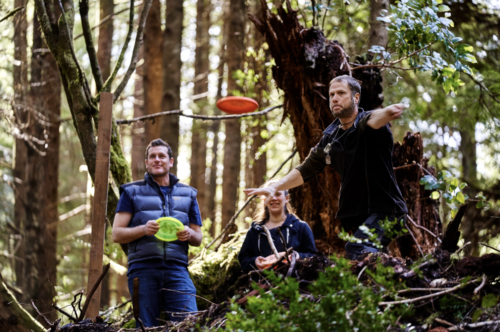
They can be loud and raucous, or adorably lazy. They’re both goofy and intelligent creatures. Visitors to the Oregon Coast go out of their way to spot sea lions, for good reason. They’re fun to watch as they lounge on the docks, interacting with each other and sliding in and out of the sea with a surprising grace.
But how much do you really know about sea lions? Both Steller and California sea lions live on the Coast — the former year-round, the latter seasonally. Steller sea lions — which are larger and lighter in color — breed here (tending to congregate at the Sea Lion Caves in Florence), while California sea lions breed in the warmer waters off the California Coast. The females stay there with their pups while the males make the treacherous trek north for food during the winter. They have other fascinating habits as well.
We sat down with Brittany Blades, a senior marine mammalogist at the Oregon Coast Aquarium, who’s been working with sea lions and other mammals for the past six years.
Q: What challenges do sea lions face in the ocean?
For California sea lions, there’s an “unusual mortality event” happening off the California Coast — there’s not enough fish to sustain all of them. It makes more sense for the males — not all, but some, to leave and go north. With climate change, the ocean water is getting warmer. There’s also lots of fishing, and pollution. That’s a big trifecta there. Stellar sea lions off the Oregon Coast — which were delisted from the endangered species list in 2013 — have also seen an alarming decline, due to boat strikes, pollutants, habitat degradation, illegal hunting and indirect and direct actions from fisheries.
Q: Why do sea lions tend to congregate at certain spots along the Oregon Coast, like Astoria, Newport and the Oregon Caves in Florence?
Most likely, they come to be protected from the elements. They’re going into the caves, the bay, where the waves aren’t that intense. It’s an easier place for them to rest. There’s also safety (from their predators, which include orcas and great white sharks). They go wherever it’s easiest to haul out too. And in the Columbia River there’s more salmon coming through there — that’s a big factor in that location.
Q: Besides salmon, what else do they eat?
Sardines, anchovies, any sort of fish they can catch. Squid, octopus and more.
Q: How many sea lions live at the Oregon Coast Aquarium?
We have five sea lions: three males and two males (Catalina, 3; Rosa, 2; Koa, 10; Max, 26 and Quill, 26). The oldest two (which came here from the Brookfield Zoo in Chicago in 1992) are much older than they’d live in the wild. Sea lions under human care live longer than out in the open ocean. They tend to develop cataracts in their 20s, so their life expectancy in the wild is their late teens, early 20s. (At the aquarium) we train them for a lot of medical behaviors, like receiving eye drops.
Q: Are there ways people can help with sea lion rehabilitation, or keeping them healthy in the ocean?
One of the biggest ways we can help keep them healthy in the ocean is by keeping trash out of the ocean. Using reusable grocery bags, reusable water bottles and coffee mugs instead of disposable items can help decrease marine debris that can harm sea lions. Also, sea lions are protected by federal law. It’s illegal for unauthorized persons to disturb, handle or feed them. If you do see a sea lion in distress, call the Oregon Marine Mammal Stranding Network, at 541-270-6830.
To see the sea lions:
- Visit the Oregon Coast Aquarium to watch their sea lion training sessions every day at 11 a.m. and 3 p.m. Tune in to the sea lion Aquari-cam to watch them frolic from afar. Get a smooch from a sea lion at the aquarium’s Valentine’s Day Kisses event, Feb. 11-12, Feb. 14 and Feb. 18-19, $25 for members and $35 for nonmembers. And hear how the trainers work with the sea lions on Enrichment Day, March 28.
- Visit the new sea lion viewing platform this summer at Newport’s historic bayfront, which will include educational signage and separate people from boat traffic. The platform and newly constructed pilings and docks are owned by the nonprofit Newport Sea Lion Docks Foundation.
- Check out the Newport sea lion web cam, updated every 15 seconds.
- And visit these superb spots to see sea lions and other wildlife along the Oregon Coast.
Story by Jen Anderson
Photo by Justin Bailie



